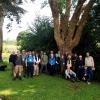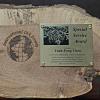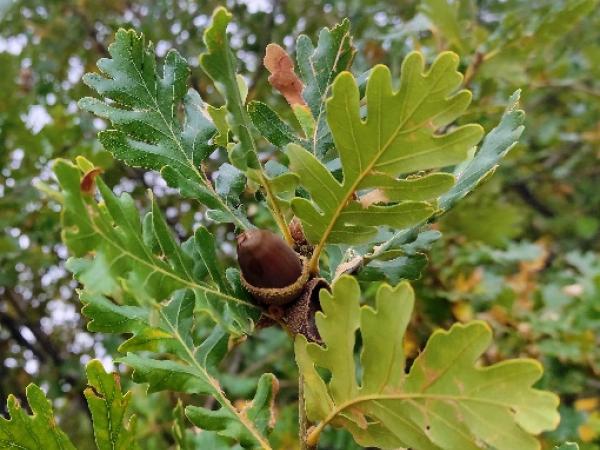Editor's Picks
Plant Focus
Al Keuter and Paul S. Manos
Published May 2019 in International Oaks No. 30: 191–202
Abstract
Like water from an incredibly slowly leaking faucet the recognition of the four species (Fig. 1) of the California Floristic Province (CA-FP) native Red Oaks (Quercus, section Lobatae, series Agrifoliae) has dripped out one at a time over nearly two hundred years. The eleven currently accepted taxa – four species including eight varieties plus three named hybrids – were each described by different authors, most prior to 1890. A recent study (Hauser et al. 2017) combining both morphological and molecular analysis has finally examined all eleven taxa simultaneously. Morphometric and DNA sequence (RAD-Seq) results are in general agreement, confirming the four California Red Oak species to be distinct while also identifying two samples as F1 hybrids. Here we describe and interpret the taxonomic history of the Agrifoliae and provide a detailed synthesis of the findings which have consequences to biodiversity and conservation concerns. We conclude that: 1) DNA analysis establishes the Agrifoliae to be a discrete clade separate from and sister to the combined Eastern North America and Mexican Red Oaks, splitting from them roughly 30 million years ago; 2) Q. wislizeni is not composed of two varieties as described by Engelmann; 3) Q. parvula var. tamalpaisensis is of hybrid origin, not a variety of Q. parvula; 4) DNA analysis reveals an unnamed F1 hybrid (Q. kelloggii × Q. parvula var. shrevei); and 5) both morphological and DNA analyses suggest Q. parvula var. parvula is a hybrid, but sample sizes are too small to confirm this.
Keywords
hybridization, introgression, Lobatae, morphometrics, phylogeny, Quercus hybrids, RAD-Seq, taxonomy
References
Axelrod, D.I. 1983. Biogeography of oaks in the Arcto-Tertiary province. Annals of the Missouri Botanical Garden 70: 629-657.
De Candolle, A.P. 1864. Prodromus Systematis Naturalis Regni Vegetabilis. 16(2.1): 67.
Díaz Fernández, P.M. 2000. Variabilidad de la fenología y del ciclo reproductor de Quercus suber L. en la Península Ibérica. Doctoral Thesis, Universidad Politecnica de Madrid.
Dodd, R. and P. Papper. 2019. Disentangling the phylogenetic network of the California red oak clade (Quercus, section Lobatae, series Agrifoliae). International Oaks 30: XXXX.
Engelmann, G., and A. Gray. 1845. Plantae Lindheimerianae; an enumeration of the plants collected in Texas, and distributed to subscribers, by F. Lindheimer, with remarks, and descriptions of new species, etc. Boston J. Nat. Hist. 5: 245.
Engelmann, G. 1878. About the oaks of the United States. Trans. Acad. Sci. St. Louis 3: 396.
Engelmann, G. 1880. Quercus. In: Geological Survey of California (Volume 2: Botany), Edited by W.H. Brewer. Cambridge, MA: University Press.
Greene, E.L. 1887. New species, mainly Californian. Pittonia 1: 40.
Greene, E.L. 1889-1890. Illustrations of West American Oaks From Drawings By The Late Albert Kellogg, M.D., text by Edward L. Greene. Vols. 1 & 2. San Francisco, CA: Bosqui Engraving and Printing Co.
Hauser, D.A., A. Keuter, J.D. McVay, A.L. Hipp, and P.S. Manos. 2017. The evolution and diversification of the red oaks of the California Floristic Province (Quercus Section Lobatae, series Agrifoliae). American Journal of Botany 104(10): 1-15.
Howell, J.T. 1931. A variant of the coast live oak. Madroño. 2:38.
Langer, S.K. 1993. A new oak on Mount Tamalpais. The Four Seasons: Journal of the Regional Parks Botanic Garden 9(3): 21-30.
Kellogg, A. (1855) 1873. Proceedings of the California Academy of Natural Sciences. 1(1): 25. Reprint, Proceedings of the California Academy of Natural Sciences. 1(2): 23.
Kellogg, A. 1863. Description of Two New Species of Plants. Proceedings of the California Academy of Natural Sciences. 2(1): 36.
Keuter, A. 2018. Observations of hermaphroditic late-season flowering in the red oak Quercus agrifolia. Phytoneuron 19: 1-5.
McMinn, H.E., E.B. Babcock, and F.I. Righter. 1949. The Chase oak, a new giant hybrid oak from Santa Clara County, California. Madroño 10: 51.
McVay, J.D., D. Hauser, A.L. Hipp, and P.S. Manos. 2017. Phylogenomics reveals a complex evolutionary history of lobed-leaf white oaks in western North America. Genome 60: 733-742.
Muller, C.H. 1938. Further studies in southwestern oaks. Amer. Midl. Nat. 19: 587.
Newberry, J.S. 1857. Botanical Report: No. 1—Report upon the Botany of the Route. Reports of Explorations and Surveys to Ascertain the Most Practicable and Economical Route for a Railroad from the Mississippi River to the Pacific Ocean VI(3): 28, f. 6, 89.
Née, L. 1801. Anales De Ciencias Naturales. 3: 271.
Nixon, K.C. 1980. A Systematic Study of Quercus parvula Greene on Santa Cruz Island and Mainland California. Master’s Thesis (unpublished), UCSB.
Nixon, K.C., and C.H. Muller. 1994. New names in California oaks. Novon 4(4): 391-393.
Torrey, J. 1853. Botany. In: Report of an expedition down the Zuni and Colorado Rivers. Editor: L. Sitgreaves. Washington: Robert Armstrong, Public Printer.
Wolf, C.B. 1944. The Gander oak, a new hybrid oak from San Diego County, California.. Proceedings of the California Academy of Natural Sciences 25: 177-188.
Wolf, C.B. 1938. California Plant Notes I. Rancho Santa Ana Botanic Garden Occas. Papers 1: 47-52.















